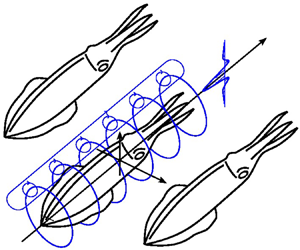
Three-dimensional schools of hydrodynamically axisymmetric swimmers self-propelling at a constant velocity are studied. We introduce a low-order model for the induced velocity based on the far-field approximation. We inquire if, by holding suitable relative positions in the three-dimensional space, the swimmers can reduce the overall energy consumption of the school in comparison with the same number of isolated individuals at the same velocity. We find a considerable (several per cent) energy saving achievable by chain formations. The benefit increases asymptotically with the number of individuals, towards a finite limit that is a function of the minimum allowed spacing between each pair of neighbours.
G. Li, L. Duan, J. Sesterhenn, R. Godoy-Diana, B. Thiria, & D. Kolomenskiy
Journal of Fluid Mechanics, 974, A34 (2023).
doi: 10.1017/jfm.2023.802